凤凰职教中职英语book4 unit 1 words
- 格式:doc
- 大小:51.00 KB
- 文档页数:3
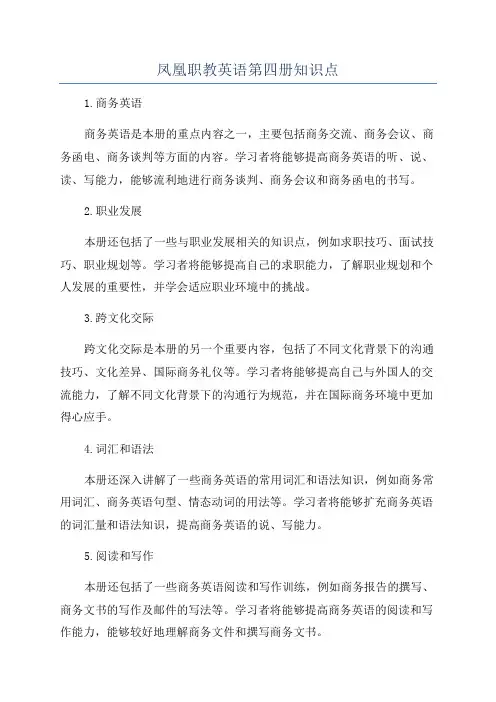
凤凰职教英语第四册知识点1.商务英语商务英语是本册的重点内容之一,主要包括商务交流、商务会议、商务函电、商务谈判等方面的内容。
学习者将能够提高商务英语的听、说、读、写能力,能够流利地进行商务谈判、商务会议和商务函电的书写。
2.职业发展本册还包括了一些与职业发展相关的知识点,例如求职技巧、面试技巧、职业规划等。
学习者将能够提高自己的求职能力,了解职业规划和个人发展的重要性,并学会适应职业环境中的挑战。
3.跨文化交际跨文化交际是本册的另一个重要内容,包括了不同文化背景下的沟通技巧、文化差异、国际商务礼仪等。
学习者将能够提高自己与外国人的交流能力,了解不同文化背景下的沟通行为规范,并在国际商务环境中更加得心应手。
4.词汇和语法本册还深入讲解了一些商务英语的常用词汇和语法知识,例如商务常用词汇、商务英语句型、情态动词的用法等。
学习者将能够扩充商务英语的词汇量和语法知识,提高商务英语的说、写能力。
5.阅读和写作本册还包括了一些商务英语阅读和写作训练,例如商务报告的撰写、商务文书的写作及邮件的写法等。
学习者将能够提高商务英语的阅读和写作能力,能够较好地理解商务文件和撰写商务文书。
6.口语和听力本册还注重口语和听力的训练,提供了大量的商务英语口语和听力材料,并提供了相应的练习和任务。
学习者将能够提高商务英语的口语和听力水平,能够更好地与外籍人士进行商务交流。
总体来说,凤凰职教英语第四册主要涵盖了商务英语、职业发展和跨文化交际等方面的内容。
学习者将能够提高商务英语的听、说、读、写能力,了解职业发展和跨文化交际的重要性,并能够在职业环境中流利地进行商务交流。
通过学习本册教材,学习者将能够获得更好的职业发展机会,并在国际商务环境中更加得心应手。
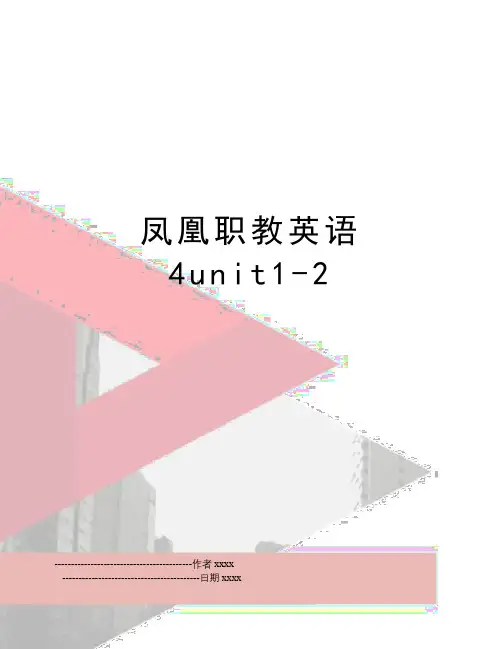
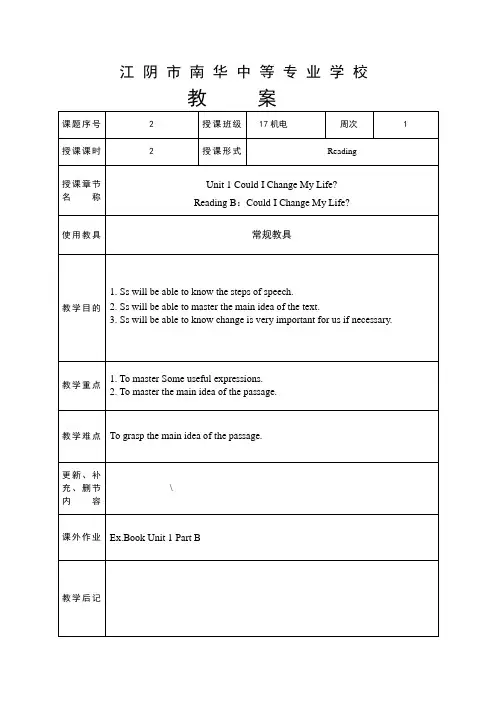
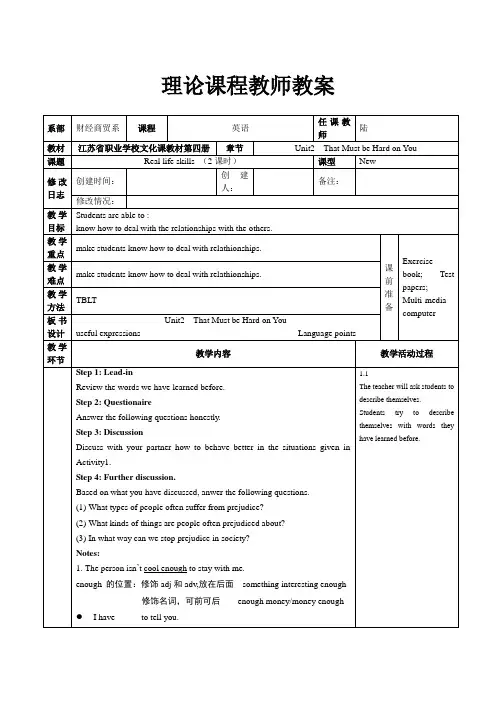
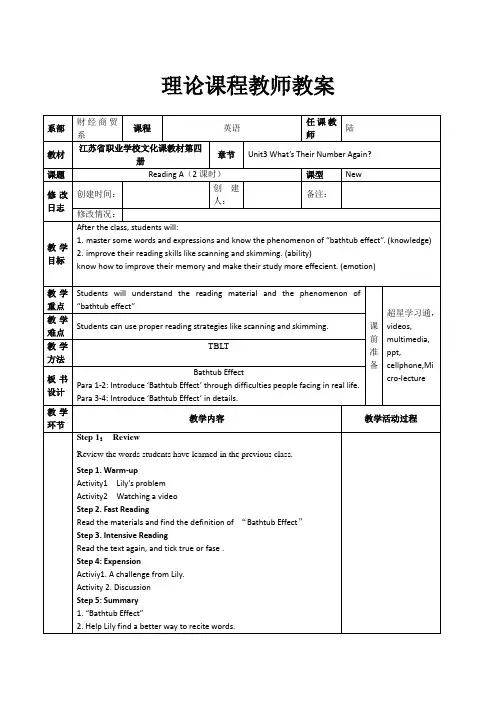
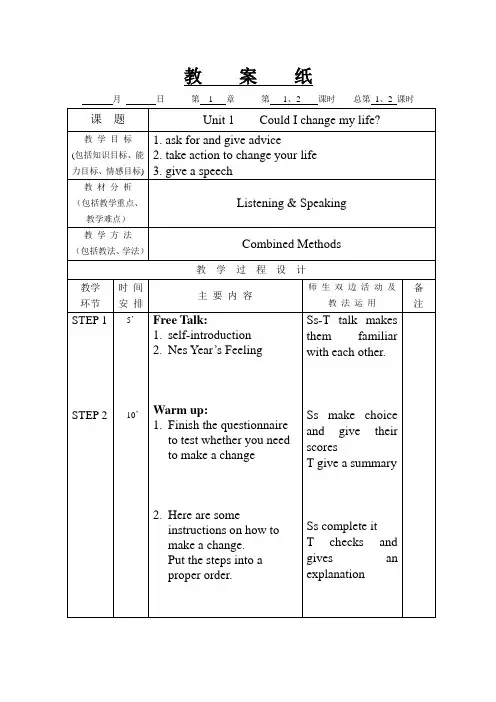
月日第 1 章第1、2 课时总第1、2 课时
(教学环节一般包括复习旧课、导入新课、讲授新课、学生操作、教师点评、归纳总结、布置作业等)
月日第 1 章第3、4 课时总第3、4 课时
(教学环节一般包括复习旧课、导入新课、讲授新课、学生操作、教师点评、归纳总结、布置作业等)
月日第 1 章第5、6 课时总第5、6 课时
(教学环节一般包括复习旧课、导入新课、讲授新课、学生操作、教师点评、归纳总结、布置作业等)
月日第 1 章第7、8 课时总第7、8 课时
(教学环节一般包括复习旧课、导入新课、讲授新课、学生操作、教师点评、归纳总结、布置作业等)。
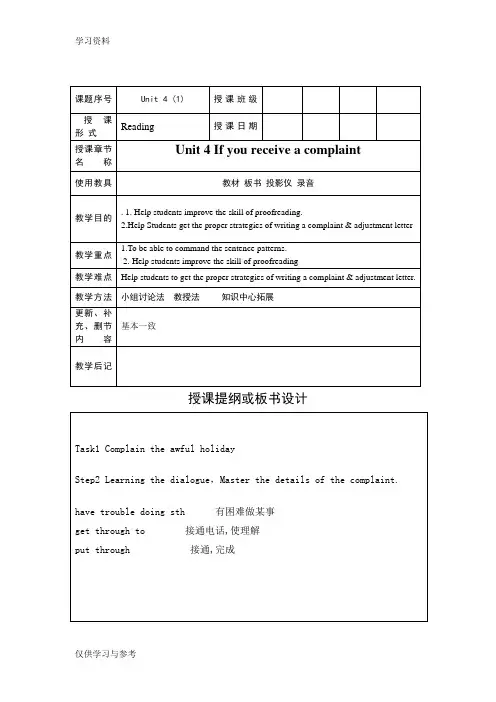
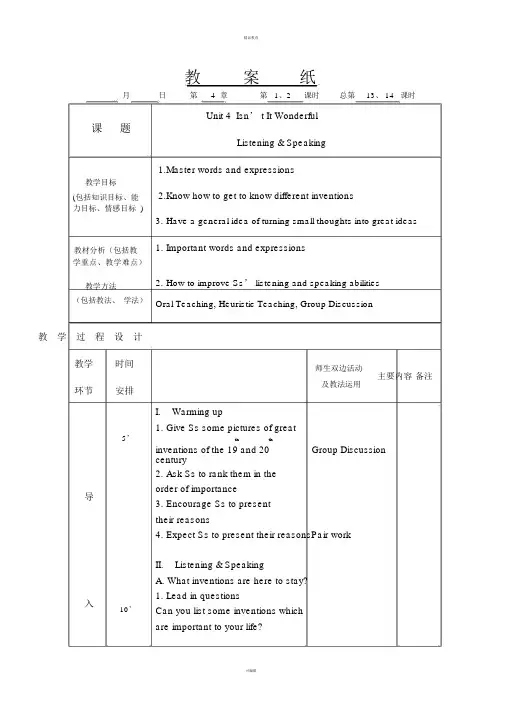
精品教育教案纸月日第 4 章第 1、2课时总第13、 14课时Unit 4 Isn’ t It Wonderful课题Listening & Speaking1.M aster words and expressions教学目标(包括知识目标、能 2.K now how to get to know different inventions力目标、情感目标 )教材分析(包括教学重点、教学难点)教学方法(包括教法、学法)3.Have a general idea of turning small thoughts into great ideas1.Important words and expressions2.How to improve Ss’ listening and speaking abilitiesOral Teaching, Heuristic Teaching, Group Discussion教学过程设计教学时间环节安排师生双边活动主要内容备注及教法运用I.Warming up1. Give Ss some pictures of great导入5’10’th thGroup Discussion inventions of the 19 and 20century2.Ask Ss to rank them in theorder of importance3.Encourage Ss to presenttheir reasons4.Expect Ss to present their reasonsPair workII.Listening & SpeakingA. What inventions are here to stay?1. Lead in questionsCan you list some inventions whichare important to your life?2. Words and ExpressionsInventions, clearly, display, pocket, HeuristicTeaching laser, type, anywhere, smartphone, 10’讲Oral Teaching教学时间环节安排主要内容师生双边活动备注及教法运用unbox, videophone, afford,model,serious, modern, electronic,reporter, gadget授3.Listening ActivityFor the first time25’Listen to the passage and circle the Ss’Presentationinventions mentioned in it.新For the second timeListen again and tick true of false.课15’归15’纳总10’结操3’练2’作For the third timeListen again and fill in the blankswith the information you’ ve heard.4. Speaking ActivityRole-play reading the passagePresent the passage in own wordsGroup Discussion 5. B Isn’t It Wonderful?(1)Listen to the conversationand circle the best answer.(2)Complete the conversationwith the sentences in the box.Oral Teaching III. SummaryWords and ExpressionPassageIV. Homework业考勤见教学日志教学体会(教学环节一般包括复习旧课、导入新课、讲授新课、学生操作、教师点评、归纳总结、布置作业等)教案纸月日第4章第3、4课时总第15、16课时Unit 4 Isn’t It Wonderful?课题Reading & WritingMaster words and expressions 教学目标(包括知识目标、能Know how to flexibly apply reading skills力目标、情感目标)Understand how to write教材分析(包括教学重点、教学难点)教学方法(包括教法、学法)Understand difficult words and expressions Discuss the impact of inventionsOral teaching, Group Discussion, Ss’ Presentation教学过程设计教学时间环节安排复5’习10’导入15’主要内容I. RevisionWords and expressions inListening & SpeakingII. Warming upSay something about greatinventions in your life Whatdo you think of them?III.Reading 1.Pre-reading(1) Words andexpressions Words:recharge, disposable, laptop, article,programme, microwave, lab,engineer, generate, high-frequency,wave, intrigue,popcorn, kernel, tube,curious师生双边活动备注及教法运用Oral TeachingSs’ PresentationOral Teaching精品教育讲授教学时间环节安排thirty years ago, modern electronic Explanation师生双边活动主要内容备注及教法运用操练讲30’授新课归25’纳总结5’product, out of, forget to do sth,recharge my phone, come back,answer message, hi-tech invention,get lost2. While-readingParagraph 1: These inventionsare great! How could you workwithout them?Paragraph 2-3: The comparisonbetween 30 years ago and nowParagraph 4: make good useof gadget and make life better3. Post-reading(1)Read the passage andtick inventions that Jan likes.(2)Match the words withtheir explanations.(3)Read the passage again andtick the best summary of it.IV. SummaryThe main idea of the passageV. Homework.Finish exercise on exercise bookGroup DiscussionOral TeachingGroup Discussion精品教育操练作业考勤见教学日志教学体会(教学环节一般包括复习旧课、导入新课、讲授新课、学生操作、教师点评、归纳总结、布置作业等)教案纸精品教育月日第4章第5、6课时总第17、18课时Unit 4Isn’t It Wonderful?课题教学目标(包括知识目标、能力目标、情感目标)Passage B & Grammar & Exercise Master words and expressionsHave the ability to make ellipsisKnow how to finish exercise efficiently教材分析Know how to apply ellipsis(包括教学重点、How to improve reading abilities教学难点)教学方法(包括教法、学法)Oral Teaching, Group Discussion 教学过程设计教学时间环节安排主要内容I. Revision 师生双边活动备注及教法运用复习5’1.Words and expressions2.The main idea of the passageII. Passage BOral Teaching操练归10’10’1.Words andexpressions Words:rise, tremendous, explode, splash,light, logic, scientific, conclusion,exposure, thus, metal, hole,electromagnetic, rapidly, refine,practical, commercial, exclusively,railroad, liner, domesticExpressions:have no idea, too--to, the nextmorning, decide to do sth, logicalscientific conclusion, be unable to doOral TeachingOral Teaching精品教育纳总结教学时间环节安排学25’生20’操练20’sth, practical use2. Reading Activity(1) Read the passage and sum up主要内容the important events in theinvention of the microwave oven.You may use the clues on the left.(2)Read the passageand circlethe best answer.(3)Read the following passageandunderline the information thatshould be included in the summary.III.GrammarEllipsis1.DefinitionageIV .Exercise1. Listening PracticeListen to the tape andfinish listening exercise2. Expressions MatchFinish this exercise by pair work师生双边活动备注及教法运用Group Discussion作 3. ClozeThe teacher explains it in detail 业4. Reading ComprehensionV. Summary & Homework1.The main idea of the passage精品教育2.The usage of ellipsis3.Finish exercise on exercise book5’考勤见教学日志教学体会(教学环节一般包括复习旧课、导入新课、讲授新课、学生操作、教师点评、归纳总结、布置作业等)。
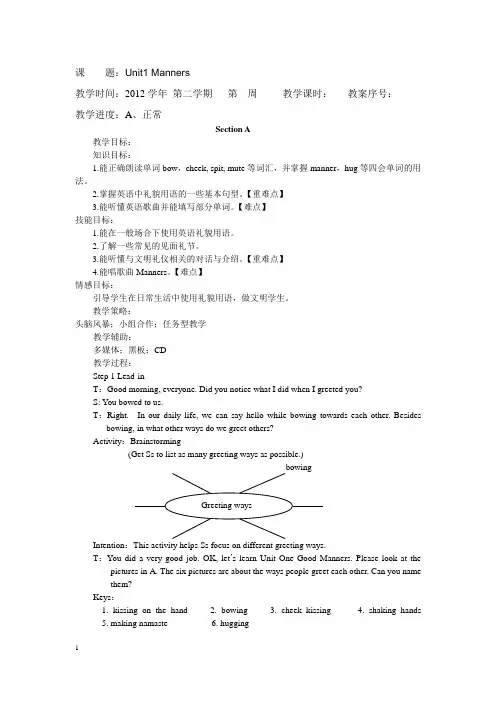
课题:Unit1 Manners教学时间:2012学年第二学期第周教学课时:教案序号:教学进度:A、正常Section A教学目标:知识目标:1.能正确朗读单词bow,cheek, spit, mute等词汇,并掌握manner,hug等四会单词的用法。
2.掌握英语中礼貌用语的一些基本句型。
【重难点】3.能听懂英语歌曲并能填写部分单词。
【难点】技能目标:1.能在一般场合下使用英语礼貌用语。
2.了解一些常见的见面礼节。
3.能听懂与文明礼仪相关的对话与介绍。
【重难点】4.能唱歌曲Manners。
【难点】情感目标:引导学生在日常生活中使用礼貌用语,做文明学生。
教学策略:头脑风暴;小组合作;任务型教学教学辅助:多媒体;黑板;CD教学过程:Step 1 Lead-inT:Good morning, everyone. Did you notice what I did when I greeted you?S: You bowed to us.T:Right. In our daily life, we can say hello while bowing towards each other. Besides bowing, in what other ways do we greet others?Activity:Brainstorming(Get Ss to list as many greeting ways as possible.)Intention:This activity helps Ss focus on different greeting ways.T:You did a very good job. OK, let’s learn Unit One Good Manners. Please look at the pictures in A. The six pictures are about the ways people greet each other. Can you namethem?Keys:1. kissing on the hand2. bowing3. cheek kissing4. shaking hands5. making namaste6. huggingT:Let’s do a quiz to see how much you know about the ways people greet each other in different countries.B:Read and chooseT:In our daily life, it is very important to be polite in communicating with others. We should pay attention to our manners, that is to say, we should be students with good manners.For example, when you meet your teacher in the morning, you should say…Ss: Good morning.T: If you run into somebody, you should say…Ss: Sorry.T: If you are in a strange place, you want to ask the way, what will you say first?Ss: Excuse me.T: If someone helps you, you should say…Ss: Thank you.T: Great. Let’s discuss in groups to complete the sentences with the proper expressions.Step 2 Listening I1A Look and sayT:We have just learnt something about greeting manners. Now let’s get to know something about the signs of good manners. Look at the signs in 1A. Talk about the signs in pairs.(Get Ss to discuss the meanings of the signs.)1B:Listen and chooseT:When we go to the cinema, what manners should we pay attention to?Ss: Keep quiet.T: Can we make a phone call there?Ss: No, we must not.T: Now, let’s listen to a dialogue between Susan and Andy to see what they are talking about.After listening, choose the right answers to 1B.(T plays the CD once or twice according to the level of Ss,and then checks the answers with the whole class. )Keys:1. A2. B3. C1C:Listen and fillT:Now, let’s listen to the CD a second time to get more detailed information about the dialogue, and then complete the sentences.(Ss listen to the dialogue again and fill in the blanks. T checks the keys with Ss.. )T:Now lets listen to the CD again and try to fill in the blanks.(Ss listen to the passage again and finish the sentences. T checks the keys with Ss. )Keys:1.talking2. want, friends3. bad manners4. turn offStep 3 Listening IIT:Do you know any good manners in foreign countries?Please give us some examples.Ss:(Discuss in groups of four and one of the students presents his group’s result.)T:So far, we have known much about good manners and bad manners in different countries.Now let’s listen to a short passage about good manners. Then match the countries with the good manners.Ss:It is too slow.T:Yes,that’s it. But you know writing letters is still very useful,especially when you are applying to a university. Do you know how to write an application letter?Ss:No/Yes.T:I can show you some .(Show some pictures of application letters. )T:Now lets listen to a dialogue about it. While listening,pay attention to the key information in the exercises on your book.1D:Listen and choose(T plays the CD. Ss listen and choose the right answer. After listening,check the answers. )Keys:England B; Korea C; Thailand A1E:Listen and decide“T”or“F”T:Nowadays more and more students in China like to study abroad . They like to do some further studies after they graduate from high schools or universities. But do you know how to write an application letter?Ss:…T:Now,lets listen to the dialogue again and decide“T”or“F”.(After listening,check the answers. )Keys:1. F2. T3. F4. FStep 4 Enjoy music2A:Listen and chooseT: OK, let’s enjoy an English song Manners.(Ss listen to music and learn to sing it.)2B: Listen and fillT: Please listen to the song again and fill in the blanks with proper words in B.(Ss listen to the song again and fill in the blanks. Then T checks the answers.)Keys:know,point,please,thank,youStep 5 Having FunT:What did you get from guests when they came to your house in your childhood?Ss: sweet, toy, etc.T: Now, let’s enjoy a funny story to see what the kid got from a guest and why the story is funny.(Ss try to read the four sentences.)T:Now lets read the English sayings. Would you please try to read them by yourselves?(Ss read the four sentences by themselves. )T:Since they are famous sayings,do you know how to translate them?Have a try.(Ss work in groups and try to translate them into Chinese. Then T asks some pairs to practice them. )Intention:Ss can show great interest in English sayings because they are short and easy to remember. while,English sayings can give us some moral education while learning.谚语译文:1.观其礼而知其人。
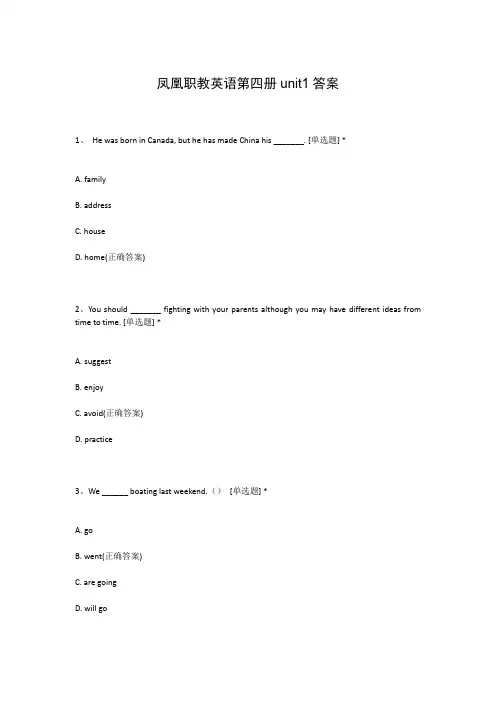
凤凰职教英语第四册unit1答案1、He was born in Canada, but he has made China his _______. [单选题] *A. familyB. addressC. houseD. home(正确答案)2、You should _______ fighting with your parents although you may have different ideas from time to time. [单选题] *A. suggestB. enjoyC. avoid(正确答案)D. practice3、We ______ boating last weekend.()[单选题] *A. goB. went(正确答案)C. are goingD. will go4、She and her family bicycle to work, _________ helps them keep fit. [单选题] *A. which(正确答案)B. whoC.itD. that5、Ladies and gentlemen, please fasten your seat belts. The plane _______. [单选题] *A. takes offB. is taking off(正确答案)C. has taken offD. took off6、She often _______ at 21: [单选题] *A. go to bedB. gets upC. goes to bed(正确答案)D. gets to7、Many young people like to _______ at weekends. [单选题] *A. eat out(正确答案)B. eat upC. eat onD. eat with8、My friends will _______ me at the airport when I arrive in London. [单选题] *A. takeB. meet(正确答案)C. receiveD. have9、_____ of the teachers in this district are women teachers. [单选题] *A. Four fifthB. Four fifths(正确答案)C. Fourth fifthsD. Four five10、( ) What _____ fine weather we have these days! [单选题] *A. aB. theC. /(正确答案)D. an11、94.—Let’s go out for a picnic on Sunday.—________. [单选题] * A.Nice to meet youB.Here you areC.The same to youD.Good idea(正确答案)12、He either watches TV _______ reads books in the evening. [单选题] *A. or(正确答案)B. andC. toD. so13、While they were in discussion, their manager came in by chance. [单选题] *A. 抓住时机B. 不时地C. 碰巧(正确答案)D. 及时14、Be careful when you _______ the street. [单选题] *A. are crossingB. is crossingC. cross(正确答案)D. is cross15、Hearing that he had passed _____ health examination, he immediately made _____ call to his parents. [单选题] *A. a; /B. the; /C. the; a(正确答案)D. a; the16、I can’t hear you _______. Please speak a little louder. [单选题] *A. clearly(正确答案)B. lovelyC. widelyD. carelessly17、pencil - box is beautiful. But ____ is more beautiful than ____. [单选题] *A. Tom's; my; heB. Tom's; mine; his(正确答案)C. Tom's; mine; himD. Tom's; my; his18、If the manager had to choose between the two, he would say John was _____ choice. [单选题] *A. goodB. the bestC. betterD. the better(正确答案)19、At half past three she went back to the school to pick him up. [单选题] *A. 等他B. 送他(正确答案)C. 抱他D. 接他20、Jack can speak Japanese, and his brother can _______ speak Japanese. [单选题] *A. tooB. also(正确答案)C. eitherD. as well21、Mum, this T-shirt is much too small for me. Would you buy me a _______ one? [单选题] *A. niceB. largeC. nicerD. larger(正确答案)22、I often _______ music from the Internet. [单选题] *A. download(正确答案)B. spendC. saveD. read23、4.—Let's fly a kite when you are ________ at the weekend.—Good idea. [单选题] * A.warmB.kindC.smallD.free(正确答案)24、57.Next week will be Lisa's birthday. I will send her a birthday present ________ post. [单选题] *A.withB.forC.by(正确答案)D.in25、The strawberries ______ fresh. Can I taste (品尝) one?()[单选题] *A. watchB. tasteC. soundD. look(正确答案)26、The beautiful sweater _______ me 30 dollars. [单选题] *A. spentB. paidC. cost(正确答案)D. took27、Once you get on the road, here are some traffic _______ to remember. [单选题] *A. problemsB. positionsC. rules(正确答案)D. points28、The man lost his camera and he ______ it now.()[单选题] *A. foundB. is findingC. is looking forD. looks for(正确答案)29、You should finish your homework as soon as possible. [单选题] *A. 赶快地B. 尽能力C. 一...就D. 尽快地(正确答案)30、I am so excited to receive a _______ from my husband on my birthday. [单选题] *A. present(正确答案)B. percentC. parentD. peace。
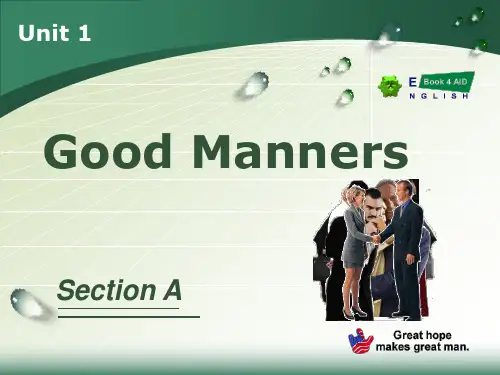
Unit 4 It’s a nice party!一、单元内容分析本单元的话题是聚会。
教学重点是关于聚会的词汇和句型。
具体为:掌握关于聚会类型、天气状况、饮料等词汇;能运用聚会上关于主人招待客人、客人回应主人的句型,聚会时主宾之间选择合适的交流话题(如谈论天气等)及对应的句型结构;能够读、写活动备忘录。
本单元的语法点是人称代词和物主代词的用法。
相对其他单元而言,本单元的话题内容并不是学生所熟悉的,因此,教师需要通过多种途径激发学生的学习兴趣和参与热情,在教学设计中强调集体配合和合作互助的精神。
形象化的图片教学和有适当紧张度的游戏和表演,不仅能吸引学生的注意力,而且能强化教学效果。
同时教师在课堂上应不断提供适时的语言帮助和鼓励,扫除学生在学习过程中碰到的障碍,有助于克服学生的畏缩心理,使他们积极主动地配合教学活动,真正成为课堂活动的主体。
本单元设计分为4个课时:第一课时Lead in + Listening and speaking第二课时Reading and writing第三课时Grammar focus (Possessive pronouns)第四课时V ocabulary practice + Supplementary reading二、分课时教学设计第一课时 Lead in + Listening and speaking 一、教材分析1.教学内容本课时系《英语基础教程1》第四单元的第一课时,包括Lead in 和Listening and speaking两部分,具体内容为:关于聚会类型、天气状况、饮料的词汇;聚会上关于主人招待客人、客人回应主人的对话,聚会时主宾之间合适的交流话题(如谈论天气等)及对应的句型结构。
这些内容为整个单元的学习活动做语言和知识的准备,也为学生语言表达活动进行语言铺垫。
2.教学重点、难点⑴教学重点掌握关于聚会类型和天气的词汇、短语;在聚会情景中能招待客人、回应主人;并谈论天气等话题;⑵教学难点了解并合理运用听力策略;找出适合聚会中交流的有趣话题;二、教学目标1.知识目标⑴掌握聚会类型和天气状况的词汇、短语,如:dancing party,Christmas party,dinner party,welcome party,garden party,birthday party;weather,snowy,rainy,windy,sunny,cloudy,foggy; cappuccino, latte.⑵掌握在聚会上招呼客人及作为客人予以恰当回应、谈论天气等话题的句型,如:Welcome to my party!What a nice party!What’s the weather like in …?It’s ….Would you like some something to drink?Here you are.Make yourself at home.2.能力目标⑴能听懂聚会中的简单对话,以及关于天气的简单表述;⑵能在模拟的聚会场景中迎接客人并恰当回应;⑶能运用所学语言在恰当场合谈论天气;3.情感目标能找出适合聚会中交流的有趣话题,并了解我们应在跨文化交流时尊重他人的风俗习惯。
凤凰职教book4 Unit2电子教案Take students to read the picute of Parti and guesswhat’s happening to Jim.Listen to the conversation and circle what Jim is upset about.Then correct the answer.Listen again and complete the Part2 True or False.And tell the reasons to the class.Try to encourage to complete the part3 by themselves by using theinformation they have got in the before Twice’s listening.教学反思Stepl RevisionHave a dictaionSome important words: aggressive, gentle,patient,amazing, fun, bossy .....Students can describe their partners by the words we have learned last class.Step2 ListeningFirst listening:Take students to learn the three sentences and to know their chinese meanings.Listen to the tape recorder and find out the problem mentioned in each item.(Tell students to catch the key information when they are listening and take some notes.)Second Listening:Read the five sentences and try to complete the conversations with them.Ask two students to practise the conversations .Listen again and check their answers.some useful phrases:talk behind my back, all sorts of lies, ask him for help. Step3 Conversation StrategUnderstandingGenuine compassionMake you be in a similar situationBe a good listenerStep4. Work with a partner. Role-play the following e the conversation strategy in Acivity5. Situation 1: ......Situation 2: ......Situation 3: ......教学反思Ask some students to read the passageA one by one.Students can express that how to be friendly and charming by their own words. Complete the exercise 2 and check the answers with others.Step3 DiscussionWhat else can be done to improve friendships?Divide the students into several groups and talk with each other.教学反思different from themselves is a great relationship match. Be different from 与。
理论课程教师教案
(1)做(不合法的,错的或蠢的事)commit murder
(2)commit to do sth 承诺做某事
●He is such an honest person that he can’t have ____ the theft.
A.done
B. committed
C. commit
D. do
12.get sth done/ have sth done/ make sth done 使...让...
get sb to do sth/ have sb do sth/ make sb do sth 让某人做某事
●They ___ me ___my imaginantion.
A.make; to use
B. get ; use
C. have; to use
D. get; to use
13.difficulty n. 困难(不可数);难事(可数)
without difficulty
have difficulty in doing sth
It’s difficult for sb to do sth
●People in the southwest of China have _____ difficulty ______ water,
and the govenment is trying to help.
A.a lot; getting
B. much; getting
C. a lot of; to get
D. much; to get
14.Connect A with B 把A和B联系在一起
They fit closely together and connect with each other (表联系)
This early bus from the village connects with the 8:30 train. (表示汽车,火车,飞机等交通方面的相通)
Connect A to B 把A联接到B上
Click here to connect to the Internet.
Activity3 Read by themselves.
Activity4 Read the words together once again
Step5 conclusion
Step6 Homework。